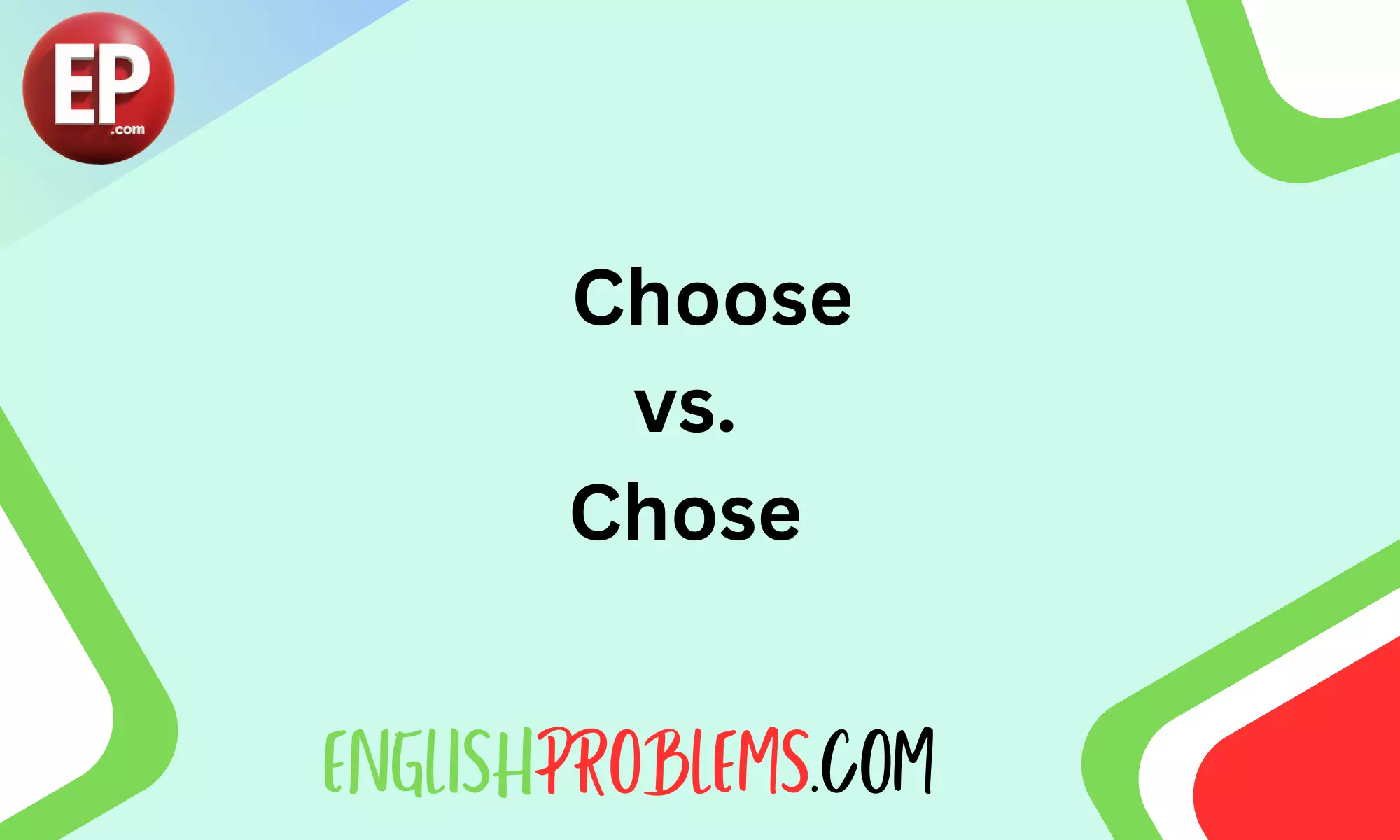Understanding the differences between “choose” and “chose” is crucial for anyone looking to master the English language. These words often cause confusion due to their similar spelling and pronunciation, but their usage is distinct and context-specific.
In this blog post, we’ll dive deep into the nuances of “choose” and “chose,” providing you with the knowledge and tools to use them correctly in your writing and speech.
Understanding ‘Choose’: Definition and Usage in Present Tense
Definition of “Choose”
The word “choose” is a verb that means to select from a number of possibilities. It is an irregular verb, and its present tense form is used to express decisions made in the current time.
Examples of “Choose” in Sentences
- I choose to eat healthy foods every day.
- They always choose the scenic route for their road trips.
- Do you choose to stay in or go out tonight?
Contexts Where “Choose” is Commonly Used
“Choose” is often used in everyday situations where decisions are made. It can be about selecting food, making lifestyle choices, or picking options in various scenarios. Understanding the context helps in correctly using “choose.”
The Basics of ‘Choose’ in Sentences
Simple Present Tense Usage
“Choose” is primarily used in the simple present tense. It’s straightforward and indicates that the action of selecting is happening now or regularly.
Affirmative, Negative, and Interrogative Forms
- Affirmative: I choose this book.
- Negative: I do not choose the red one.
- Interrogative: Do you choose this option?
Example Sentences
- I choose to exercise every morning.
- She chooses her outfits carefully.
- They choose to volunteer at the shelter every weekend.
Irregular Verbs and Their Present Forms
Explanation of Irregular Verbs
Irregular verbs do not follow the standard rules for conjugation. Instead of adding “-ed” for the past tense, they often change their form entirely.
Comparison with Other Irregular Verbs in Present Tense
Here’s a table comparing “choose” with other common irregular verbs:
| Verb | Present Tense | Past Tense |
| choose | choose | chose |
| go | go | went |
| see | see | saw |
| take | take | took |
| make | make | made |
Table of Common Irregular Verbs
This table provides a quick reference to some of the most commonly used irregular verbs and their forms:
| Verb | Present Tense | Past Tense |
| be | am/is/are | was/were |
| become | become | became |
| begin | begin | began |
| break | break | broke |
| bring | bring | brought |
Tips to Remember ‘Choose’ as an Action Verb
Mnemonics and Memory Aids
Using mnemonics can help remember the correct form of “choose.” For example, associate “choose” with the word “choose now” to emphasize its present tense usage.
Visual Aids
Creating visual aids like flashcards can reinforce the memory of irregular verb forms. Write “choose” on one side and “chose” on the other, with an example sentence for each.
Practical Examples
- When you choose, you are deciding in the moment.
- “I always choose the healthier option,” she said.
The Past Tense Puzzle: When to Use ‘Chose’
Definition of “Chose”
“Chose” is the past tense form of “choose.” It indicates that the action of selecting happened in the past.
Examples of “Chose” in Sentences
- Yesterday, I chose to stay home instead of going out.
- They chose a beautiful spot for their picnic.
- She chose the blue dress for the party last night.
Contexts Where “Chose” is Commonly Used
“Chose” is used in contexts where decisions were made in the past. It is important to recognize the timeframe to use this form correctly.
Common Confusions: Navigating Between ‘Choose’ and ‘Chose’
Common Mistakes and Misconceptions
One common mistake is using “choose” when referring to past actions. This error can confuse readers and listeners.
Real-World Examples of Misuse
- Incorrect: Last week, I choose to visit my grandparents.
- Correct: Last week, I chose to visit my grandparents.
Strategies to Avoid Confusion
- Think about the timing of the action. If it happened in the past, use “chose.”
- Practice with example sentences to solidify understanding.
Mnemonics to Distinguish ‘Choose’ from ‘Chose’
Memory Aids and Tricks
- “Choose” is like “choose now,” emphasizing the present.
- “Chose” sounds like “chose then,” indicating the past.
Visual Mnemonics
Visual mnemonics can include pictures or symbols that represent the present and past. For example, a ticking clock for “choose” and a calendar for “chose.”
Example Sentences
- Present: I choose to read a book today.
- Past: I chose to read a book yesterday.
Guidelines for Non-Native Speakers
Common Pitfalls for ESL Learners
Non-native speakers often struggle with irregular verbs because they don’t follow typical conjugation rules.
Tips and Strategies for Mastering These Verbs
- Practice regularly with flashcards and quizzes.
- Listen to native speakers and pay attention to verb usage.
- Write sentences using both forms to reinforce learning.
Cultural Context and Language Nuances
Understanding the cultural context can also help. For example, English speakers often make quick decisions, hence the frequent use of “choose.”
The Role of Context in Choosing the Correct Form
Importance of Context in Language
Context is crucial in determining which verb form to use. The timeframe and situation guide the correct usage of “choose” or “chose.”
Examples Highlighting Contextual Differences
- Context: Making a decision now.
- “I choose to walk to work today.”
- Context: Recalling a past decision.
- “I chose to walk to work yesterday.”
Exercises to Practice Context-Based Usage
- Fill-in-the-blank: I __________ (choose/chose) to eat pizza last night.
- Multiple choice: She __________ (choose/chose) her words carefully in the meeting.
Pronunciation and Understanding Through Audio Examples
Audio Clips for Pronunciation Practice
Hearing the correct pronunciation can aid in understanding. Listen to audio examples to practice.
Phonetic Breakdown of “Choose” and “Chose”
- Choose: /tʃuːz/
- Chose: /tʃoʊz/
Common Pronunciation Mistakes and How to Correct Them
Ensure you pronounce the ending sounds distinctly. Practice with tongue twisters and repetition.
Practical Exercises to Master ‘Choose’ and ‘Chose’
Fill-in-the-Blank Exercises
Complete the sentences with the correct form:
- I always __________ (choose/chose) the red apple.
- Last night, he __________ (choose/chose) the movie we watched.
Sentence Transformation Activities
Rewrite the sentences in the past tense:
- I choose to travel by train.
- They choose the team leader every year.
Contextual Usage Practice
Write sentences based on given scenarios:
- Scenario: Deciding on dinner plans now.
- Sentence: I __________ (choose/chose) to have pasta tonight.
Interactive Quizzes to Test Your Knowledge
Multiple-Choice Quizzes
Select the correct form:
- I __________ (choose/chose) to study abroad.
- a) choose
- b) chose
True/False Statements
Determine if the statements are correct:
- True or False: Yesterday, I choose to go hiking.
Immediate Feedback and Explanations
Provide explanations for the answers to reinforce learning.
Learning by Writing: Create Your Sentences
Guided Writing Exercises
Write your own sentences using “choose” and “chose.”
- I __________ (choose/chose) to read this article because it’s informative.
- They __________ (choose/chose) their vacation destination last month.
Peer Review and Feedback Options
Share your sentences with peers for feedback. Discuss any corrections and why they are necessary.
Encouraging Creativity and Practical Application
Encourage creative writing using these verbs to reinforce learning and make it enjoyable.
Conclusion
Recap of Key Points
Understanding the difference between “choose” and “chose” is essential for clear communication. Remember that “choose” is present tense, while “chose” is past tense.
Final Tips and Reminders
- Practice regularly with exercises and quizzes.
- Pay attention to context and timing.
- Use memory aids and mnemonics to reinforce learning.
Encouragement to Keep Practicing and Learning
Language learning is a continuous journey. Keep practicing, and soon, choosing the correct form will become second nature.
Additional Resources
Links to Further Reading and Practice Materials
- English Grammar 101
- Irregular Verbs List
- Practice Exercises
Recommended Grammar Books and Websites
- “English Grammar in Use” by Raymond Murphy
- Purdue OWL
Contact Information for Language Learning Support
- Reach out to local language learning centers or online platforms like Duolingo for additional support and practice opportunities.
By understanding and practicing the differences between “choose” and “chose,” you will improve your English language skills and communicate more effectively. Happy learning!

Matthew Porter brings a wealth of knowledge and a vibrant enthusiasm for teaching English to the table. His innovative approach and creative explanations make even the most challenging language concepts accessible and fun. Matthew’s dedication to helping others achieve fluency is evident in every piece he writes.










